Kyoto is well-known as the cultural heart of Japan, with many traditional temples and shrines. It is home to 17 UNESCO World Heritage sites and regularly campaigns for more.
However, with so many different temples and shrines, it can be hard to narrow down which ones to see during a short visit.
Here we have the best Kyoto temples and shrines, and why you should visit them.
Best Kyoto Temples and Shrines
Kinkaku-ji Temple
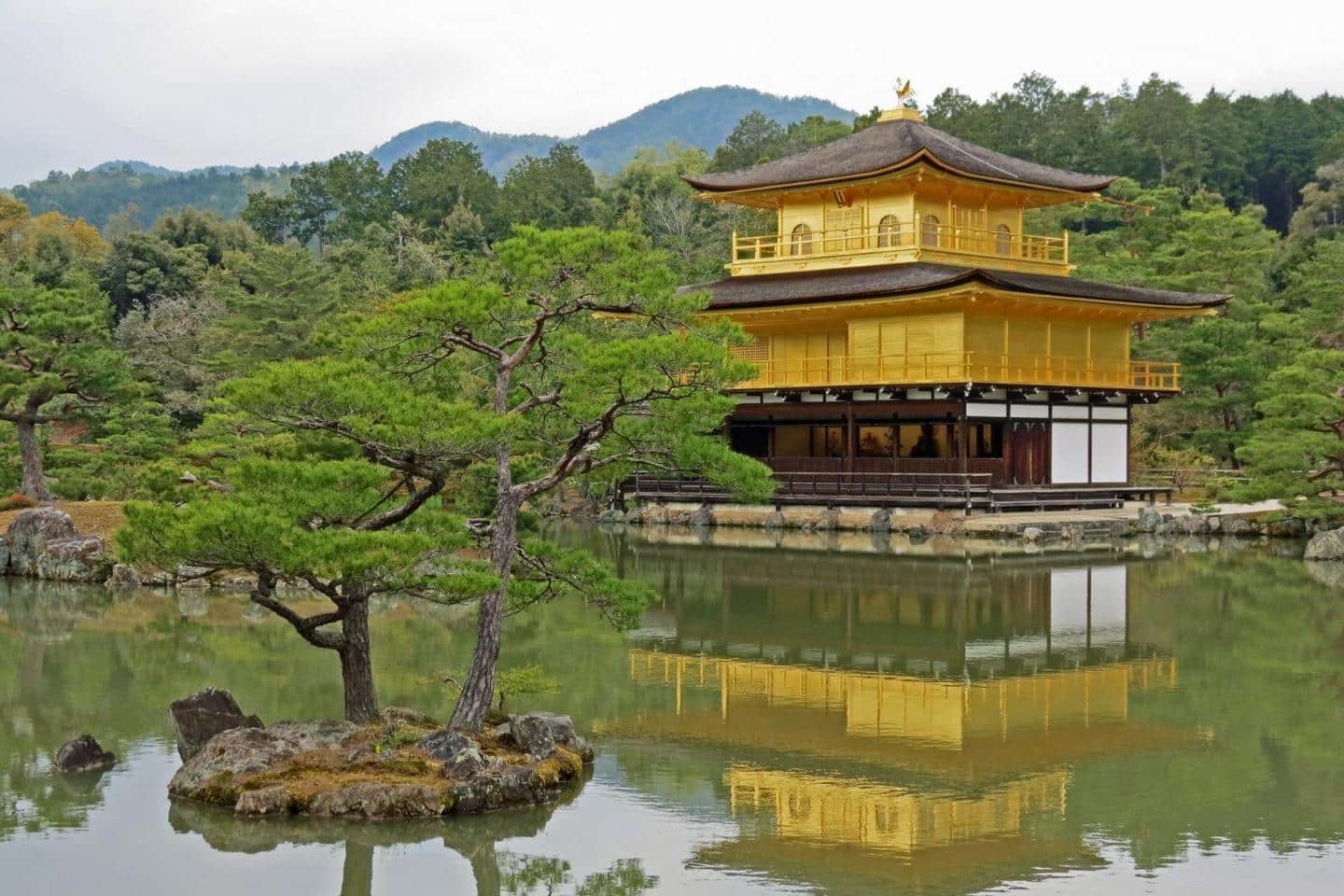
The sister temples of Kinkaku-ji and Ginkaku-ji are some of the most popular temples in Kyoto, for both international and domestic tourists.
Kinkaku-ji, or the Gold Pavilion, was first built in the late 1300s as a retirement villa for the shogun of the time, Ashikaga Yoshimitsu.
The design reflects the grandeur of the time with the top two floors being entirely covered in gold leaf.
Each floor of the main building represents a different architectural style with religious iconography inside. However, these inside statues are kept private, as the temple is sealed off from the public.
The beauty of Kinkaku-ji is to be appreciated from the outside, and the surrounding area has been perfectly designed to do so.
The surroundings perfectly complement Kinkaku-ji with a large, still pond in front of the temple and an impressive backdrop of forest and mountains.
On clear days, the forest and temple reflect back from the calm waters of the pond, creating a stunning image of peacefulness and tranquility.
It is considered one of the most picturesque sights in Kyoto regardless of season. However, it is considered especially beautiful in spring, with a backdrop of cherry blossoms.
This temple tops almost each visitor’s bucket list. It makes for a great stop on your Kyoto itinerary.
Tip: Expect huge but disciplined crowds at any time of the day. We recommend going very early in the morning and preferably on a weekday morning for the most peaceful experience.
Address:
Kinkaku-ji
1 Kinkakujicho, Kita, Kyoto
Kyoto Prefecture 603-8361
Opening hours:
9.00am – 5.00pm
Admission to Kinkaku-ji costs ¥400 for adults.
Ginkaku-ji Temple
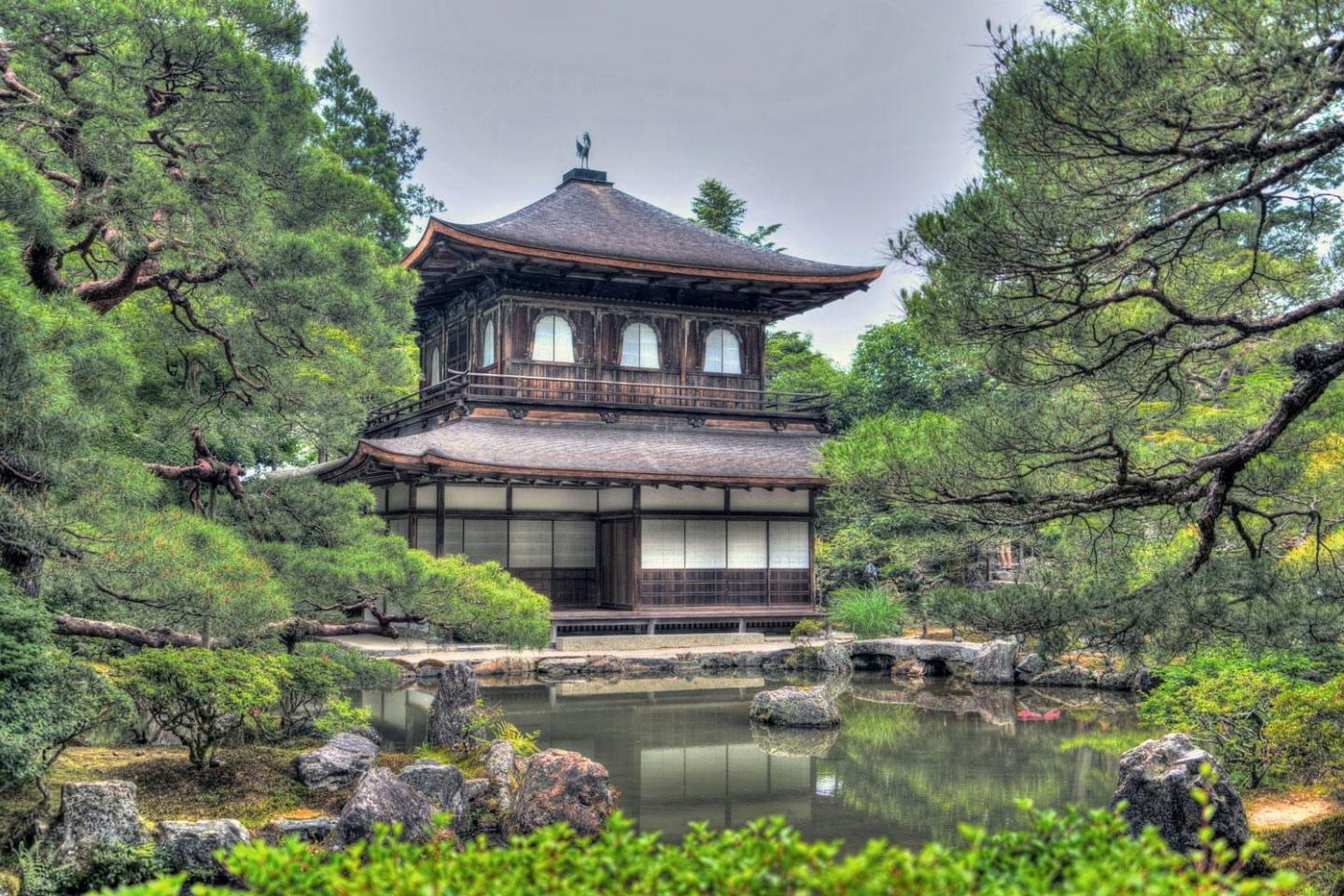
It was built by the grandson of Ashikaga Yoshimitsu, the previous shogun, using Kinkaku-ji as inspiration.
However, despite being inspired by the extravagance of Kinkaku-ji, Ginkaku-ji represented the changing culture of the time and the popularization of the arts.
While Kinkaku-ji is covered in gold leaf, Ginkaku-ji is not actually silver.
It is said that the name arose from the silvery reflection of the moon on the black lacquer of the temple.
Ginkaku-ji is much more understated and has a much closer connection to the Zen Buddhist ideals of the time. Some of the key features demonstrate this, such as the moss garden, symbolic of slow growth towards beauty.
Ginkaku-ji is also home to a sand garden, often known as the Sea of Silver Sand, which is intended to represent the peacefulness and mindfulness of Zen Buddhism.
It was made to be ideal for moon-gazing and inner reflection.
Ginkaku-ji is a landmark for a number of key cultural traditions, including the tea ceremony, flower arrangements, noh theatre and more.
It is a great contrast to Kinkaku-ji and an interesting cultural experience.
Address:
Ginkakuju
2 Ginkakujicho, Sakyo-ku
Kyoto Prefecture 606-8402
Opening hours:
March to October : 8:30am – 5.00pm
December to February: 9.00am – 4:30pm
Entry for adults costs ¥500 for access to all buildings.
Kiyomizu-dera Temple
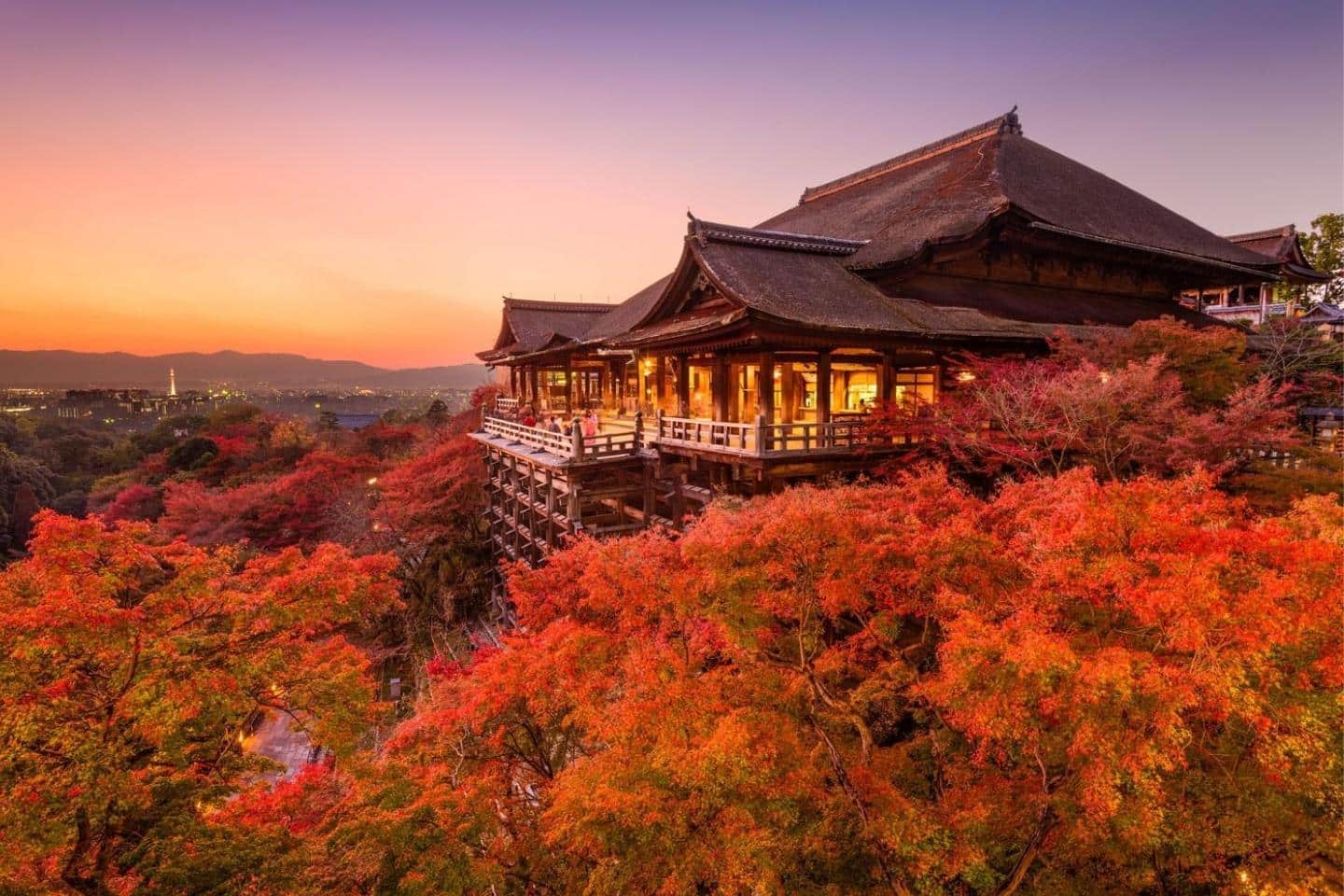
Kiyomizu-Dera is one of the oldest and most famous temples in Kyoto.
It was first built in 780 and has remained largely in its original form. It is well-known for the style of construction, as it was built entirely without nails. The woodwork is done mostly in Japanese cypress and is intricately formed to keep the structure strong without the need for nails, screws or any other fastening.
Take a look, it could totally be a backdrop for a Japanese samurai movie!
Kiyomizu-Dera is also known for its large wooden terrace, standing at 13m high. This stage is popular for its panoramic views, especially during autumn. The vivid red of Japanese maple stands out against the mountainside in a beautiful array of colors.
While these views are a key draw to the temple, the pure water for which the temple was named is another popular aspect.
A nearby waterfall has been redirected through the temple grounds and the purity and clarity of the water is considered to bring good fortune to those who drink it.
This is a common activity for school students in the lead-up to important exams and tests.
The craftmanship, the scenery, and the traditions make Kiyomizu-Dera one of the best Kyoto temples to visit.
Tip: Three times a year this temple organizes special night illuminations. They give the temple and its surrounding gardens a mystical appearance and are especially beautiful in the Sakura season.
Address:
Kiyomizu Dera Temple
294 Kiyomizu 1-chome, Higashiyama-ku
Kyoto Prefecture 605-0862
Opening hours:
6.00am – 6.00pm (until 6:30pm on weekends and holidays from mid-April to July and every day in August and September)
Entry to Kiyomizu-Dera comes to ¥400 (and it is well worth the cost).
Tofuku-ji Temple
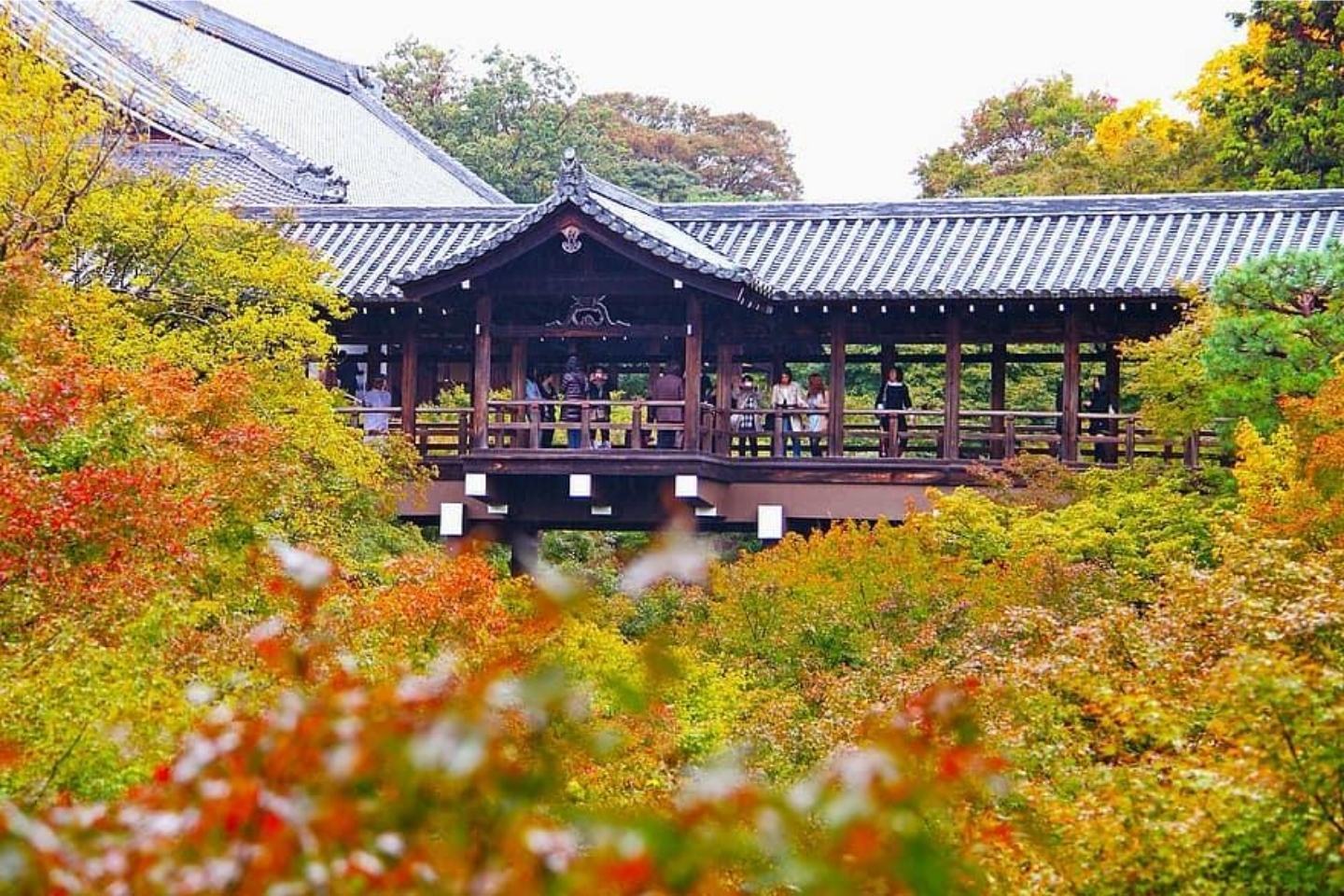
Tofuku-ji temple is a large Zen temple inspired by the Todaiji temple and Kofukuji temple of Nara, so much so that its name is a portmanteau of the two temples.
The Sanmon Gate, or gate of enlightenment, is the largest and oldest Zen temple gate in Japan. It stands at 22m with three separate entrances. The main hall is home to a large Buddha statue, a reflection of the Buddha housed at Todai-ji temple in Nara.
One of the main attractions of Tofuku-ji temple is the surrounding nature.
The temple has a number of gardens, in different styles. These include a rock garden, a pond garden, and checkerboard-patterned azaleas and sand.
The most famous of these is the ravine and the Tsutenkyo bridge crossing it. This ravine is filled with maple trees and comes to life in autumn, with a wonderful display of reds and oranges.
This bridge is considered one of the most popular spots for Autumn nature photography.
This ravine runs through the center of the temple grounds and the wooden bridge in contrast to the bright red leaves is the ideal view for Autumn.
Address:
Tofuku-ji Temple
15 Chome-778 Honmachi, Higashiyama Ward
Kyoto
Opening hours:
April to October: 9.00am – 4.30pm
November to early December: 8.30am – 4:30pm
Early December to March: 9.00am – 4.00pm
Admission ends 30 minutes before closing time.
The temple costs ¥400 for access to the bridge and main hall, with another ¥400 for further access to the other gardens and buildings.
Chion-in Temple
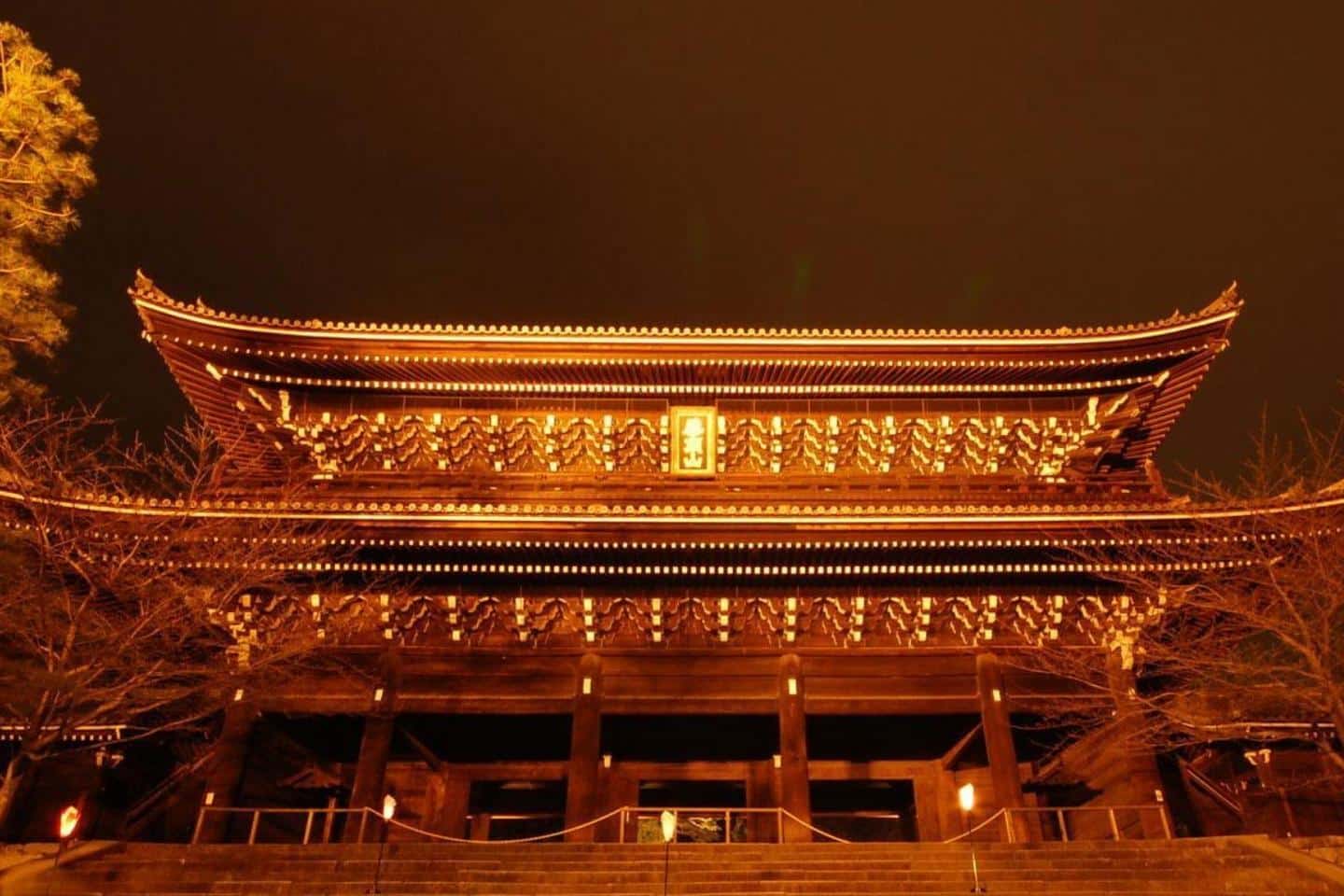
Chion-in temple is the main temple of Jodo Buddhism in Japan. It is a large, impressive temple with spacious grounds.
The main gate to Chion-in is the largest wooden gate in Japan and stands at the top of a set of stairs, making it even more imposing.
The temple bell is also the largest bell in Japan weighing 74 tons.
The temple has a number of stone paths between the different temple buildings and creates a different atmosphere to most other Japanese temples.
There are two separate gardens at Chion-in temple. One is a traditional Japanese garden and one is a more modern rock and pond garden. Both are beautiful to view and follow common Japanese design styles.
These gardens are great to view during spring, with the leafy green foliage to contrast with the large temple.
Tip: Twice a year the Chion-in temple organizes special evening illuminations. The whole temple ward is lit up by lanterns which gives it a special atmosphere. Here you can find more info about the illuminations.
Address:
Chion-in Temple
400 Rinkacho, Higashiyama Ward
Kyoto Prefecture 605-8686
It is free to enter the grounds, with a ¥500 cost to view both gardens.
Fushimi Inari Taisha Shrine
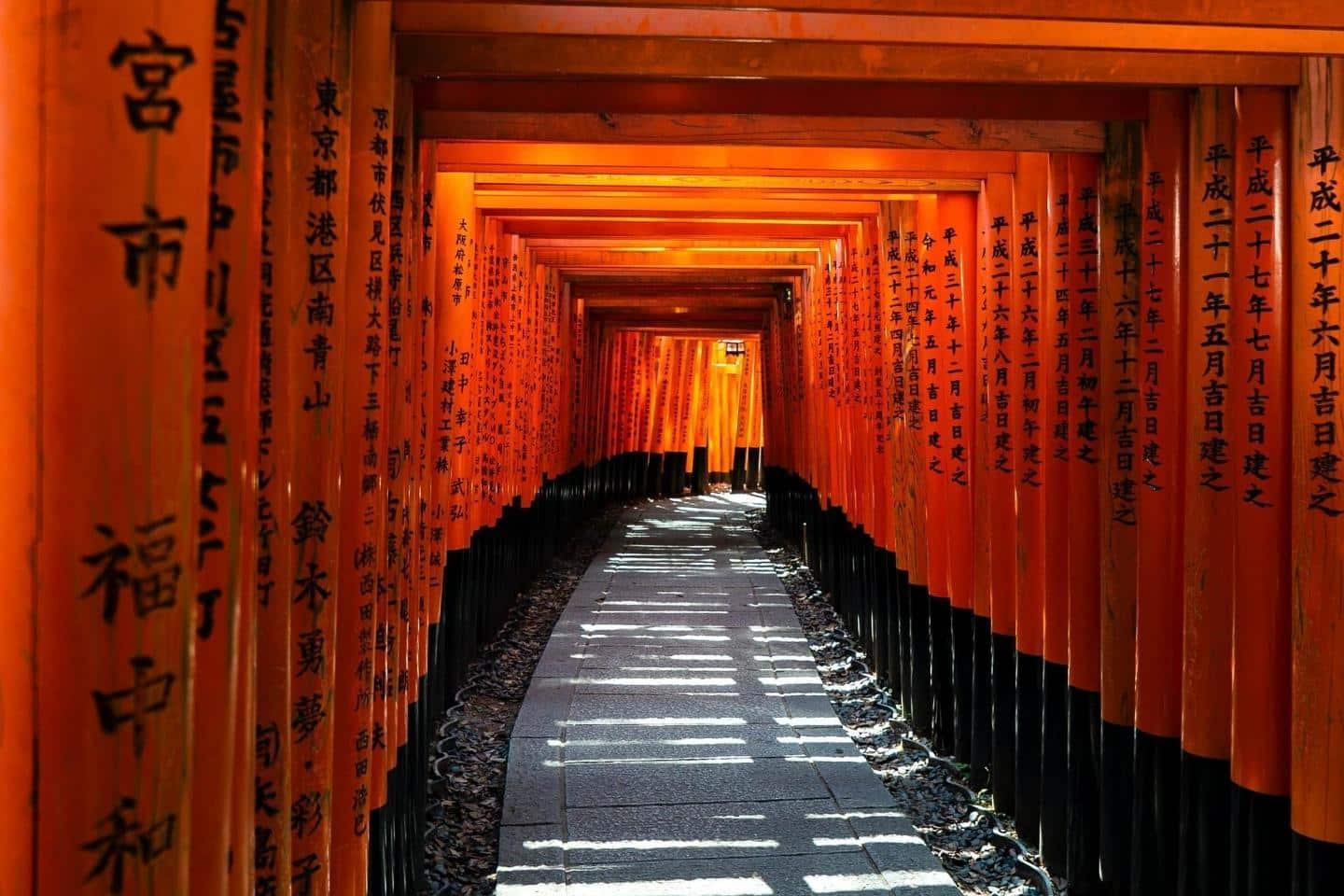
The multiple red vermillion gates create a beautiful atmosphere. Following the path of gates can take up to 3 hours and ends at the top of a mountain. However, this can be quite taxing and many visitors choose not to complete this walk.
The shrine is dedicated to “Inari”, the Shinto god of rice. The messengers of the god are spiritual foxes, and so there are many fox statues and emblems at the shrine.
Fushimi Inari Taisha is considered the most important of all Inari shrines.
While the shrine is beautiful year-round, it is less popular during summer due to the high humidity and heat.
Considering the amount of walking needed, it is best to visit the shrine during a cooler month. The most popular times are early spring and autumn.
Tip: Don’t forget to grab an Ema, a traditional Japanese wish cash card, during your visit and make a wish. You can also sample some fortune cookies, you can find them in the shape of a fox head. They also make a great souvenir.
Address:
Fushimi Inari Taisha shrines
68 Fukakusa Yabunouchicho, Fushimi-ku
Kyoto Prefecture 612-0882, Japan
The shrine is free and visitors encouraged to spend as much or as little time as they wish on the shrine grounds.
Eikan-do Temple

One of the most interesting aspects of Eikan-do is the Amida-do building. This is the main hall housing the Amida Buddha statue. However, the statue in Eikan-do is constructed with the head turned sideways, which is highly unusual.
Eikan-do is also home to a Tahoto Pagoda, an interesting style of two-storey pagoda with the bottom floor in a square and the upper story being a circle. It is a very striking style of building.
One of Eikan-do’s largest attractions is the autumn colors. It is very popular during autumn for the range of maple trees spread throughout the temple gardens.
The temple regularly holds illuminations during autumn, in which they light up the gardens after dark to further highlight the beauty of the maple trees. These are usually held in November, when the autumn colors are at their best.
These illuminations are one of the best things to do in Kyoto at night!
Address:
Eikan-do Temple
4 8 Eikandocho, Sakyo Ward
Kyoto Prefecture 606-8445
Admission to the temple is ¥600 for most of the year. However, autumn costs are increased to ¥1,000 during the day and ¥600 for the night illuminations.
Shoren-in Temple
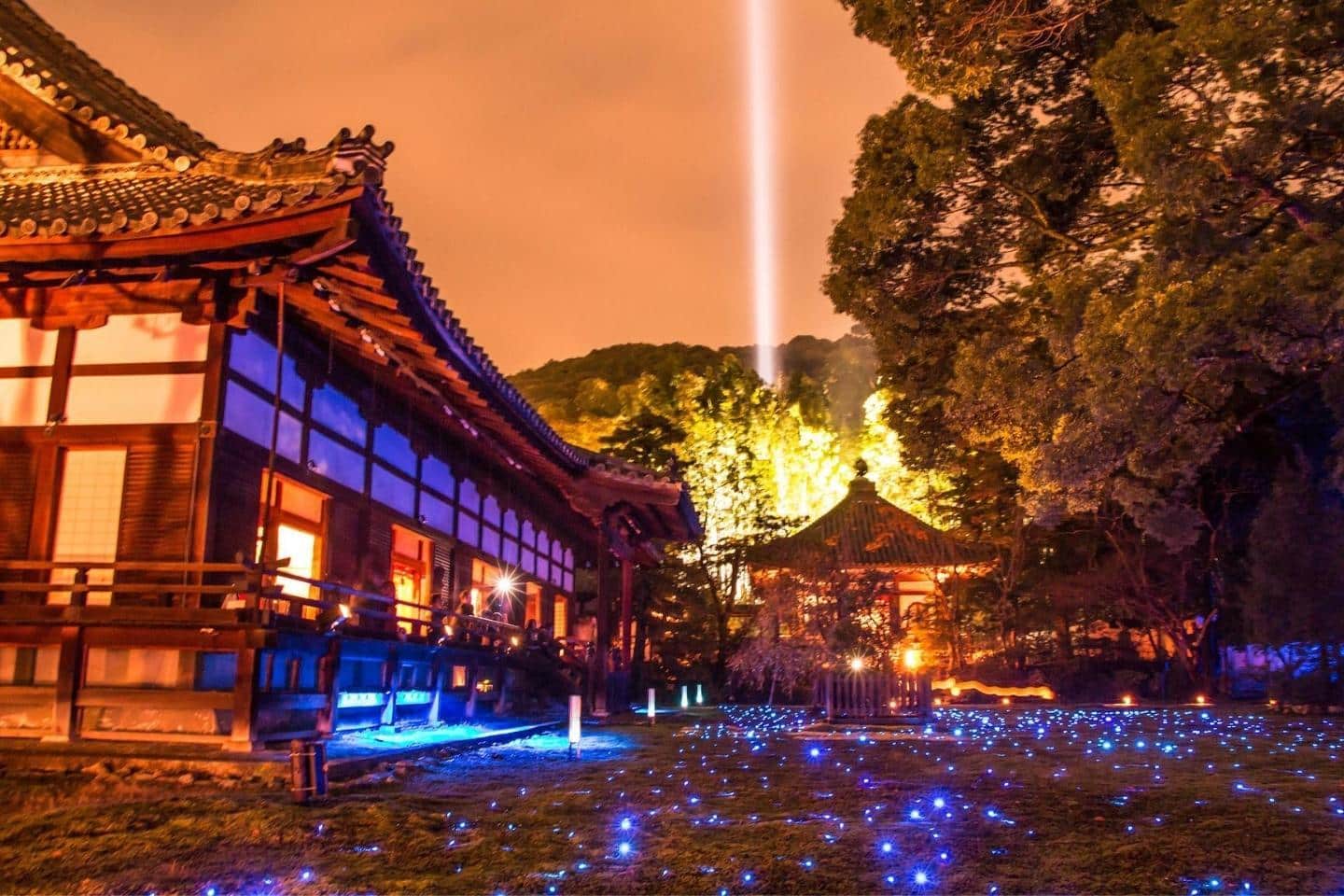
The temple has strong connections to the imperial family and has been used as a residence multiple times in history.
Shoren-in has a different set-up to most temples, in that the first place visitors walk into is the Kachoden drawing room, decorated with traditional paintings.
This drawing room then opens to look over a traditional Japanese garden and pond. The other buildings of Shoren-in are connected by wooden walkways. The main objects of worship are also different in Shoren-in, however, they are kept hidden away from the public.
While the garden is usually viewed from the Kachoden, it is also possible to walk through it. This will bring you to a bamboo grove and a moss garden surrounded by camphor trees.
The Shoren-in garden is interesting as it is continually changing. It gives the impression of being truly surrounded by nature as the main views are of the gardens. It is especially popular during spring as the garden bursts into color with the arrival of flowers.
Shoren-in temple also has evening hours during spring and autumn when the garden is illuminated with more than 1,000 blue lights creating a magical atmosphere.
Address:
Shore-in temple
69-1 Awataguchi Sanjobocho, Higashiyama Ward, Kyoto
Kyoto Prefecture 605-0035
Admission is usually ¥500, and is ¥800 during the illuminations.
Nanzen-ji Temple
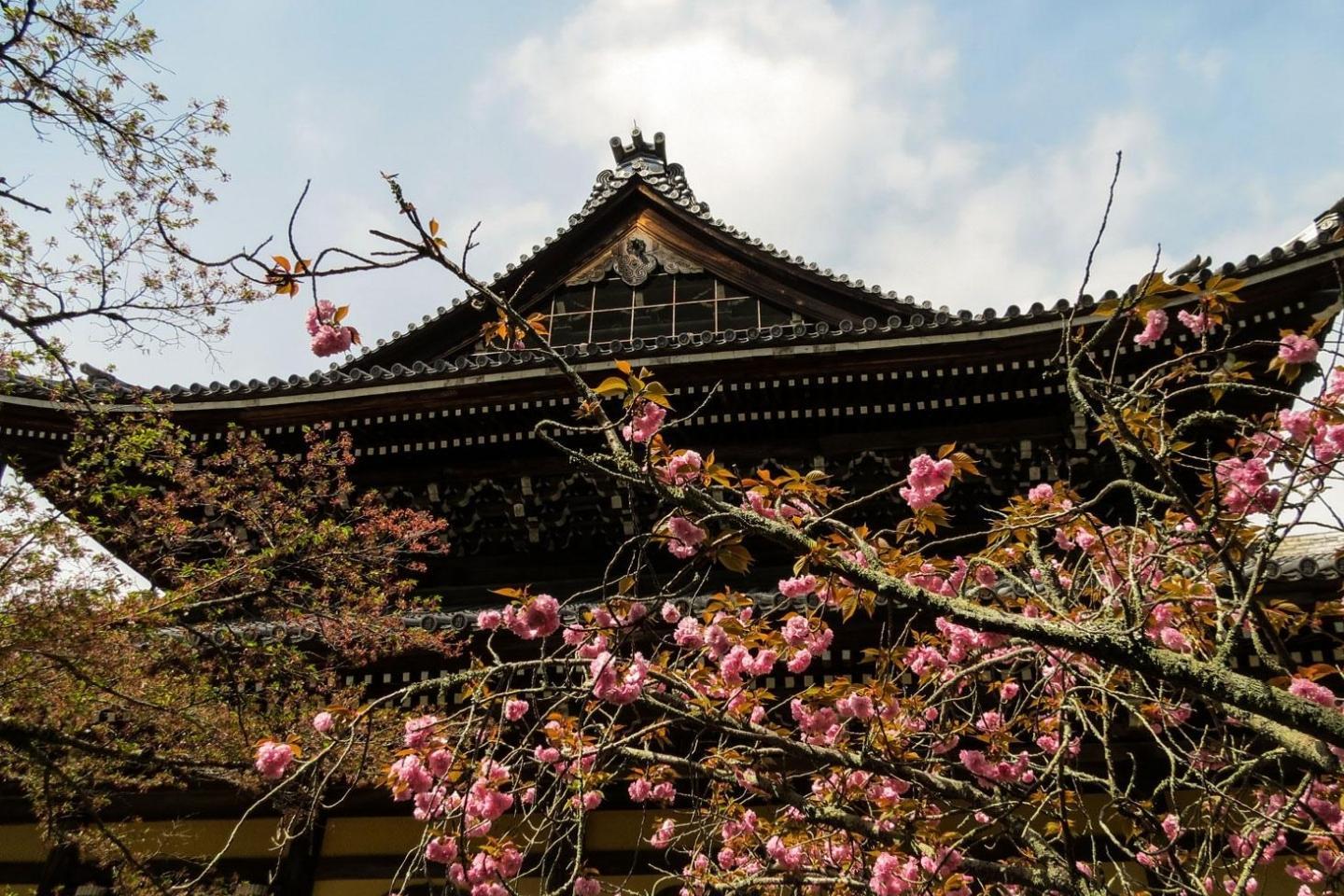
This is largely due to the complex of sub-temples on its grounds. The Sanmon Gate of Nanzen-ji is able to be entered by the public and has a viewing platform on its balcony.
From here, you can enjoy amazing views of the city of Kyoto and the surrounding landscape.
Most temples don’t allow entrance to the balcony of the gate so this is a unique experience that you definitely shouldn’t miss while you’re in Kyoto.
Nanzen-ji is also home to a large rock garden, said to represent tigers and their cubs. This is reinforced by the paintings on the sliding doors of more tigers and gold leaf.
This temple is quite unusual in that it is also home to a large aqueduct. This was built during the late 1800s, a time of modernization of Japan. It was built as part of a canal system in Kyoto to carry water and goods. This more modern style of building provides an interesting contrast with the very traditional temple grounds.
Nanzen-ji is a convenient way to see multiple temples as the sub-temples are all located on the same grounds and provide a range of temple styles in one area. Throughout these temples, there are rock gardens, traditional gardens, tea rooms and more.
Address:
Nanzenji temple
86 Fukuchi-cho, Sakyo-ku
Kyoto Prefecture 606-8435
Opening hours:
March to October : 8:30am – 5.00pm
December to February: 9.00am – 4:30pm
The central temple grounds are free to enter, however, various buildings have entrance fees. The Sanmon gate has a fee of ¥500 and the Hojo gardens are also ¥500. The connected sub-temples all have similar entry fees.
Daigo-ji
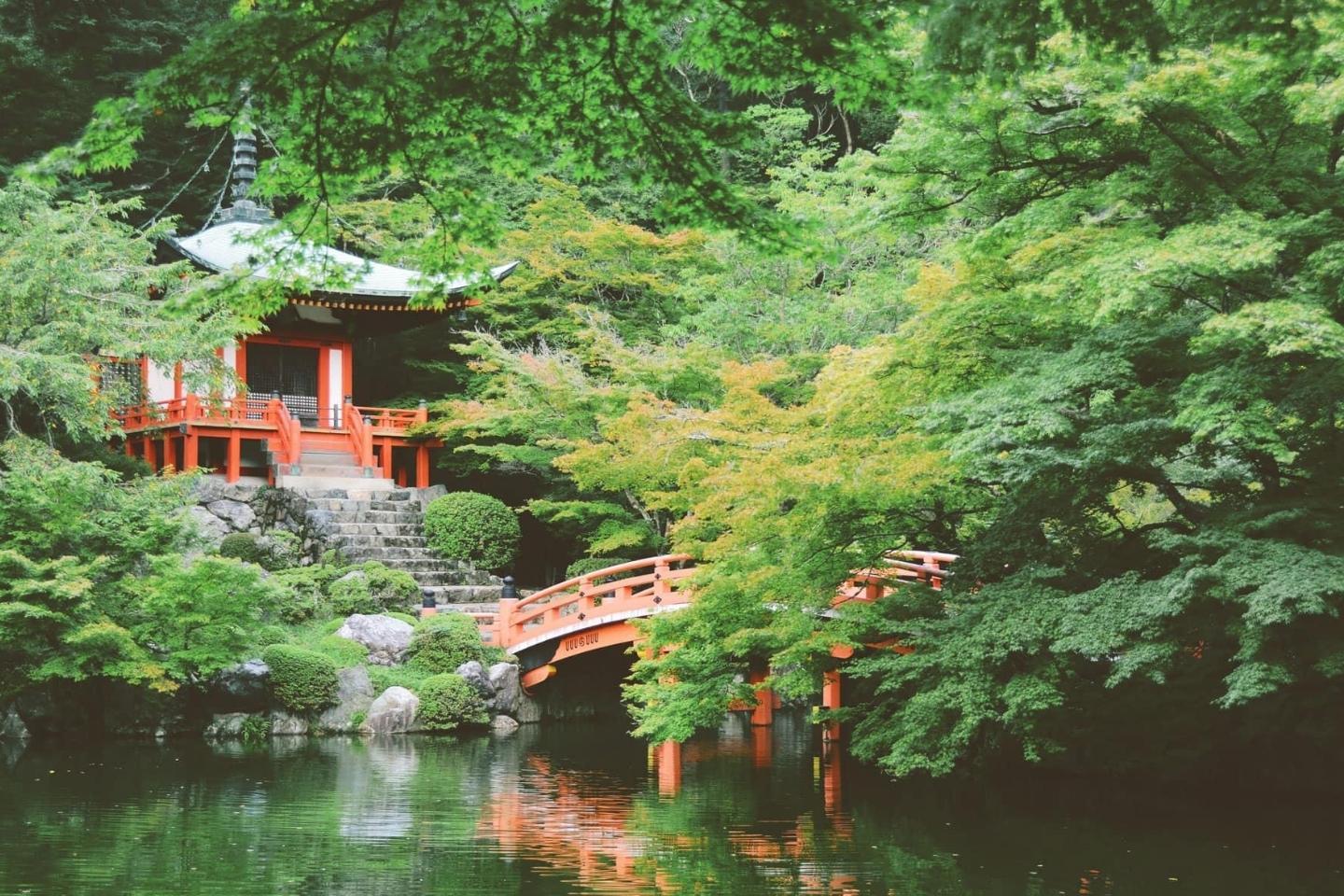
The temple grounds include the Sanboin, an example of Momoyama era architecture and the connected landscape garden.
This garden was home to the cherry blossom viewing parties of one of Japan’s most famous historical figures, Toyotomi Hideyoshi.
Daigo-ji is also home to Kyoto’s oldest verified building, a five-storied pagoda standing at 38m tall. Built in 951, it is one of the few buildings to have stayed intact throughout fires, earthquakes, and periods of political unrest in Japan’s long history.
The temple grounds also have a historical museum which displays a number of historical artifacts and documents.
The grounds of this museum have more of the beautiful cherry blossoms and the entire temple grounds are considered to be extremely beautiful during spring and the cherry blossom blooming periods.
Tip: This temple is located a bit remote and therefor is it often quieter compared to the other temples. Although still well-visited, this is a beautiful temple off the beaten track.
Address:
22 Daigohigashiojicho, Fushimi Ward
Kyoto
Opening hours:
March to November : 9.00am – 5.00pm
December to February: 9.00am – 4:30pm
Admission costs are seasonal with fees of ¥800 during summer and winter and ¥1500 during spring and autumn.
As you can see, Kyoto is home to some of the most beautiful temples and shrines in Japan and it is well-known for it for good reason! As one of the most popular tourist destinations for both international and domestic tourists, it has stood the test of time as a cultural and traditional hotspot.
With so many aspects of Japanese culture to view, it can be hard to choose which to see first. With this list, we hope you are equipped with the knowledge of the best temples in Kyoto and when to see them!
Looking for more on Japan? Check out these articles!
Inspired? Pin It!
